This site is part of various affiliate programs. Links may give us a small compensation for any purchases you make, at no additional cost to you. Please read the disclaimer policy for full details.
Overall, the Wacom Cintiq 16 is the better tablet, but in some cases, you might prefer the Huion Kamvas Pro 16.
If you’re interested in only the best drawing tablets with screens, then both the Wacom Cintiq 16 and the Huion Kamvas Pro 16 are likely to have come up in your research. These for me are among the top tablets you can currently buy.
In this article, I will cover the key real-world differences between the Huion Kamvas vs Wacom Cintiq, so you can easily see in which situations you might prefer one over the other.
Wacom Cintiq 16 vs Huion Kamvas Pro 16 Quick Comparison
My Top Pick
Near flawless drawing tablet
- 15.6 inch full HD, sharp and clear display
- Pro Pen 2 has fantastic accuracy and feels like using a real pen on paper
- Only minimal initial calibration required
- Real feel screen drawing texture
- Built in stand and VESA mount
- Excellent drivers, with a software radial menu and application-specific setup
- No programmable buttons on the tablet
- Both quite heavy and expensive
Premium anti-glare glass is a winner for professionals
- 15.6 inch full HD screen is the ideal size for most uses
- Fully laminated screen meaning a smaller gap between the pen nib and the screen (low parallax), for greater accuracy
- Has a touch bar and 6 customizable buttons
- Premium anti-glare glass looks good
- Cheaper than the Cintiq
- Relatively light weight, so suitable for travel
- Drawing surface is less premium than the Cintiq
- Requires regular calibration of the screen and pen
Key Differences of the Huion Kamvas Pro 16 vs Wacom Cintiq 16
| Differences between the Huion Kamvas Pro 16 and Wacom Cintiq 16 | 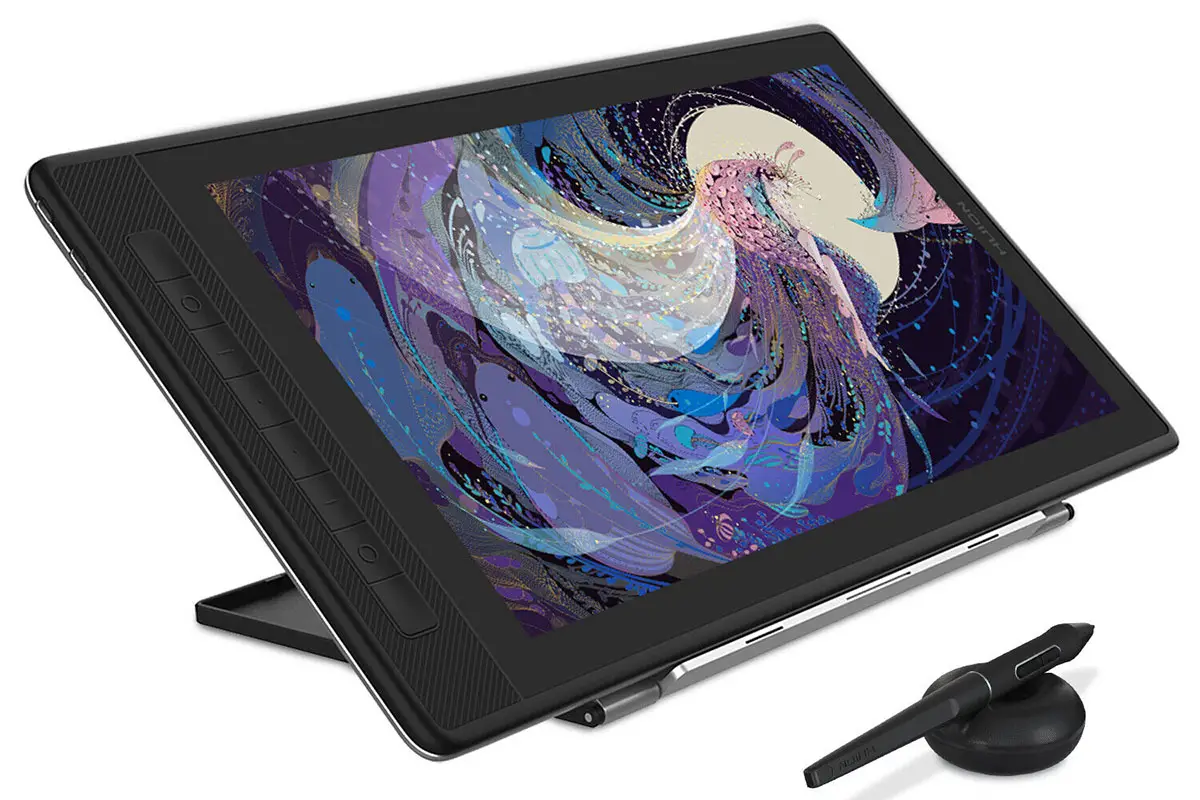 |
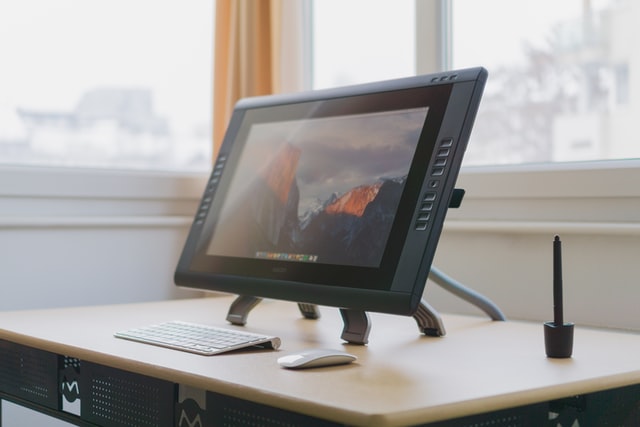 |
|---|---|---|
| Buttons |
|
|
| Color Gamut |
|
|
| Anti-Glare Glass |
|
|
| Drawing Texture |
|
|
| Screen Lamination |
|
|
| Build Quality |
|
|
| Stand |
|
|
| Stylus |
|
|
| Stylus Stand |
|
|
| Weight & Portability |
|
|
| Drivers |
|
|
| Cost |
|
|
Huion and Wacom Detailed Tablet Comparison
Shortcut Buttons
Only the Huion Kamvas Pro 16 has any shortcut buttons on the tablet itself (although both tablets have two programmable buttons on their pens). I find these very helpful in my general photo editing workflow, as they allow you to map keyboard shortcuts and speed up your work. The touch bar lets you easily change the brush size, zoom level, or anything else on a sliding scale, but doesn’t work quite as well as a dial.
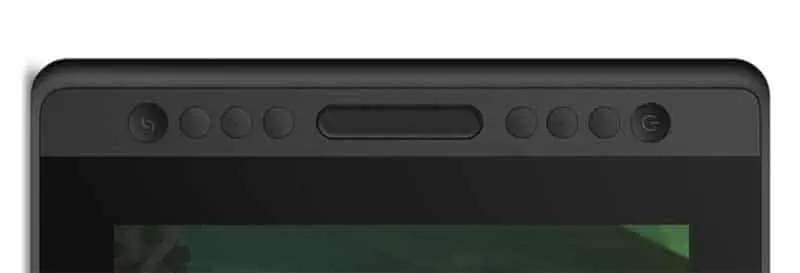
One issue with the Huion software is that it only allows you to map buttons on a global basis, whereas Wacom’s software lets you have application-specific button mapping, meaning the same button can do one thing in Photoshop, and something different in Lightroom for example.
If you need buttons on the Wacom, then you can buy the Wacom remote to wirelessly add them to the tablet.
Which Screen is Better?
Both the Huion Kamvas Pro 16 and the Wacom Cintiq 16 share a 15.6 inch full HD display. On paper, the Kamvas should be better, as it offers 120% of the sRGB gamut compared to the Cintiq’s 96%, and has a fully laminated screen with anti-glare glass fitted.
In practice, the Cintiq screen just looks more vibrant, sharper and clearer, and shows off your photos and drawings to their fullest extent. This is because the Cintiq is better calibrated in the factory, while the Huion needs much more calibration both initially and over time as the screen beds in.
Anti-Glare Glass vs Anti-Glare Film
The Kamvas is fitted with anti-glare glass, which should in theory be a more premium finish than the anti-glare film found on the Cintiq.
But Wacom have found a way of manufacturing their screens that is far superior to Huion, and use a very high quality film, resulting in the anti-glare film of the Cintiq actually having a superior texture that is more like real paper.
The texture on the Huion, by contrast, is a little smoother and more like glass, although the differences are actually fairly minimal, and will probably only be noticeable if you are already experienced with drawing tablets.
Screen Lamination
You only tend to find fully laminated screens on more premium drawing tablets, so it is a surprise to find this on the Huion Kamvas Pro 16 and not the Wacom Cintiq 16.
A fully laminated screen is one where the top layer of glass has been fully bonded to the display panel below, usually with glue, whereas a non fully laminated screen has the glass resting on top of the panel. This leaves an air gap and means that the screen as a whole is thicker.
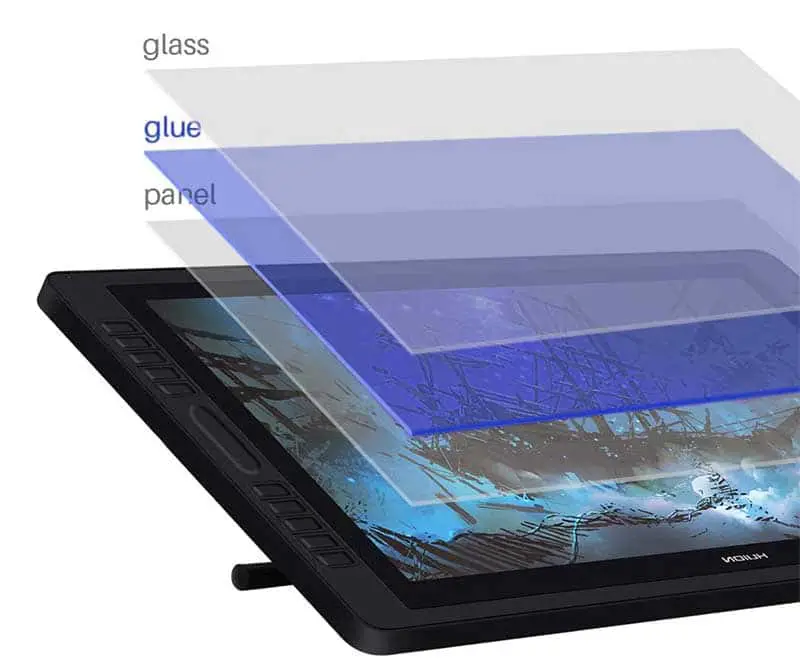
Increased screen thickness causes there to be a greater distance between the pen nib, when placed on the surface of the screen, and the cursor. This means that when viewed from an angle, the parallax effect causes the cursor to appear to be not directly underneath the nib, and can make drawing more difficult.
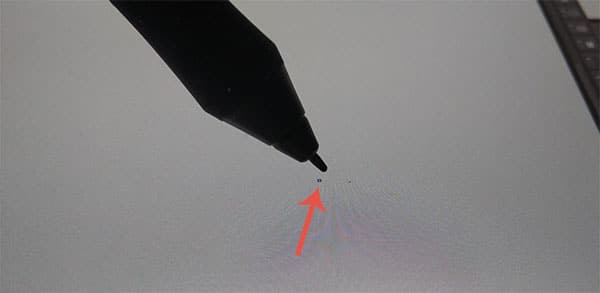
Although only the Kamvas has a fully laminated screen out of the two we are looking at here, the manufacturing process of the Cintiq means that there is also no parallax in practice. This means that the accuracy of both tablets is comparable, and you don’t need to worry about parallax with the Wacom Cintiq.
Build Quality
The Wacom Cintiq 16 feels like a premium product, with relatively thin bezels and carefully tapered edges, but the case is made entirely from plastic.

The Kamvas has a solid aluminum back, which makes the tablet feel like it can better stand up to the knocks and bumps that come with carrying the tablet around.

Combined with the significant extra weight of the Cintiq vs the Kamvas, the Kamvas is better suited to travel, and those who want a really portable tablet, while the Cintiq excels when left at a desk.
Tablet Stand
You can see from the comparison table that both tablets are fairly large and heavy. Although it is possible to use both while on your lap, ideally you would place it on a stand on a desk. This also has the advantage of letting you tilt the tablet to draw more accurately.
The Wacom Cintiq 16 is the winner with regards to the stand, as the Cintiq has a built in kickstand that lets it sit at 20 degrees. This is a really lightweight and useful addition, and compares favorably to the separate stand of the Huion Kamvas Pro 16.
The stand on the Kamvas is plastic-y and does not feel like a premium product. It can be set at multiple angles, but is just more hassle to use and doesn’t look as good as Wacom’s offering.
Another bonus of the Cintiq is that it has VESA mounting holes, which are absent on the Kamvas Pro. This lets you mount the Cintiq on a separate monitor arm, giving it an even greater range of movement when at a desk.
Stylus
Both the Pro Pen 2 of the Cintiq and the PW507 pen of the Kamvas Pro are very good, although for me the Pro Pen 2 edges it.

Both show the same specs on paper for pen sensitivity, report rate, and lines per inch, but the Pro Pen 2 just feels more natural in the hand, and exhibits less jitter, with greater accuracy in practice.
Both have two programmable buttons and both are passive, meaning that they do not need to be charged.
Stylus Stand
Both tablets come with a way to store your stylus when not in use, but neither are really that great.
The Huion Kamvas Pro 16 has a cheap-feeling plastic box that can store the pen either upright or lying horizontal. Inside, it has ten extra nibs.
The Wacom Cintiq 16 has a cloth loop that attaches to the side of the tablet, designed to hold the pen. If you detach the loop, you get access to three extra nibs.
Drivers & Software
Perhaps the area where Wacom show their class-leading performance the best is in the drivers and software provided.
With Wacom software installed, you have access to an onscreen radial menu, and can set buttons and shortcuts to be application specific, which is a massive bonus if you regularly use multiple programs for your art.
By contrast, the Huion drivers are a little more buggy, and may cause pen lag in some cases. You also cannot assign the shortcut buttons different functions for each piece of art software you use, limiting their usefulness.
Huion Kamvas Pro 16 vs Wacom Cintiq 16: The Verdict
For most people, the ultimate choice between the Huion Kamvas 16 Pro and the Wacom Cintiq 16 will come down to budget.
When you take value for money into the equation, the Kamvas becomes a much better prospect, particularly as it is offering some premium features – full lamination and anti-glare glass – and at a significantly lower price than the Cintiq.
But don’t forget that the Kamvas is also more portable than the Cintiq, even if the Cintiq itself does offer an overall better drawing performance.
So, the Huion Kamvas Pro 16 is ideal for those who want to maximize their value for money, or are on a strict budget, or who want to travel widely with their tablet.
While the Wacom Cintiq 16 suits those who value ultimate quality and are willing to pay for the absolute best.
Read Related Articles:
What are the best drawing tablets with screens?


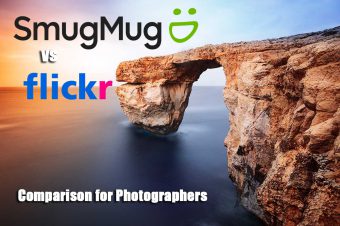

![Vertical Lines on Vizio TV Screen? [FIXED]](https://www.lapseoftheshutter.com/wp-content/uploads/2022/11/vertical-lines-on-vizio-tv-screen-340x226.jpg)
Leave a Reply